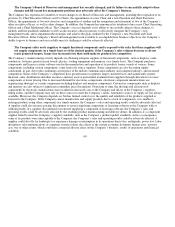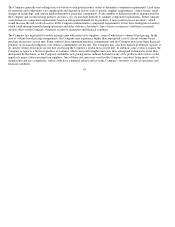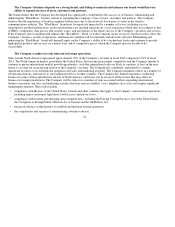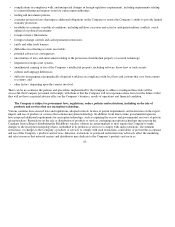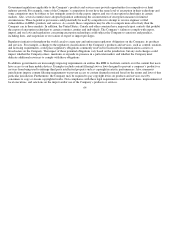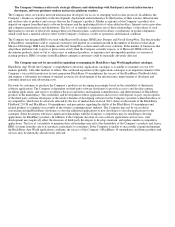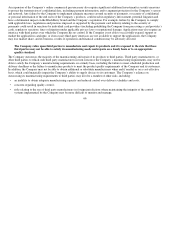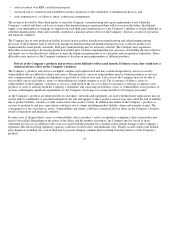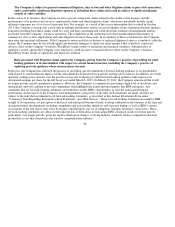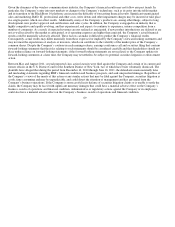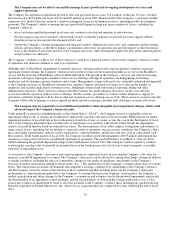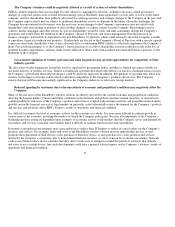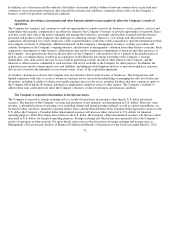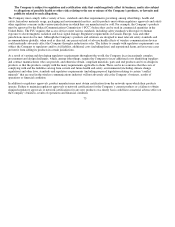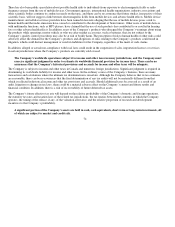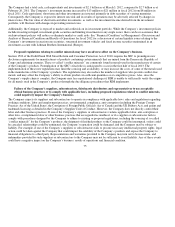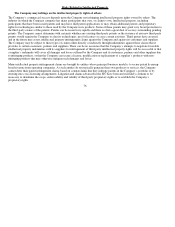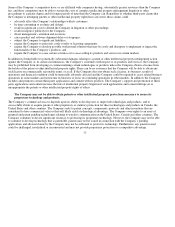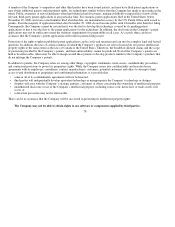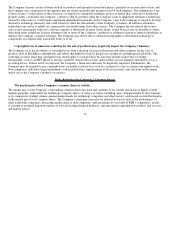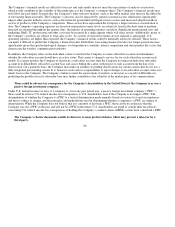Blackberry 2012 Annual Report Download - page 78
Download and view the complete annual report
Please find page 78 of the 2012 Blackberry annual report below. You can navigate through the pages in the report by either clicking on the pages listed below, or by using the keyword search tool below to find specific information within the annual report.
The Company may not be able to successfully manage its past growth and its ongoing development of service and
support operations.
The Company has experienced significant growth in sales and personnel in past years. For example, in the past 10 years, revenues
have increased to $18.4 billion in fiscal 2012 from $307 million in fiscal 2002. Rapid growth of the Company’s operations and the
expansion of its product lines have placed a strain on managerial, financial and human resources, including product development
personnel. The Company’s ability to manage this past growth will depend in large part upon a number of factors, including the
Company’s ability to:
The Company’s inability to achieve any of these objectives could have a material adverse effect on the Company’s business, results
of operations and financial condition as well as its reputation.
Although sales of BlackBerry smartphones to network operators, strategic partners and corporate partners continue to generate
significant revenue streams, the Company’s historical and current revenue is from recurring monthly access fees from BlackBerry
service and the licensing of BlackBerry software (BES and CALS). The growth in the Company’s services and software licensing
operations will require ongoing development of new service offerings and support operations, including hiring and training
employees and developing corporate standards and systems. Management systems will need to be continually enhanced and upgraded
as the Company increases its BlackBerry customer base, and the Company will need to increase or re-allocate the number of
employees and facilities dedicated to customer service, fulfillment, financial and non-financial reporting, billing and other
administrative functions. There can be no assurance that the Company has made adequate allowances for the costs and risks
associated with the expansion of these service offerings, that the systems, procedures or controls will be adequate to support its
operations, or that the Company will be able to offer and expand its service offerings successfully. There can be no assurance that the
Company will be able to manage or achieve significant future growth or manage a possible shift in business revenues effectively.
The Company may be required to record additional goodwill or other intangible asset impairment charges, which could
adversely impact the Company’s financial results.
Under generally accepted accounting principles in the United States (“GAAP”), the Company reviews its intangible assets for
impairment when events or changes in circumstances indicate the carrying value may not be recoverable. RIM performs its annual
impairment analysis of goodwill late in the fourth quarter of each fiscal year, or sooner, as was the case in the third quarter of fiscal
2012, if the Company determines there are indicators of impairment, in accordance with GAAP. Under GAAP, the impairment
analysis of goodwill must be based on estimated fair values. The determination of fair values requires assumptions and estimates of
many critical factors, including, but not limited to: expected results of operations; macroeconomic conditions; the Company’s share
price and market capitalization; industry analyst expectations; control premiums; and the discount rates used in a discounted cash
flow analysis. In the fourth quarter of fiscal 2012, the Company recorded a goodwill impairment of $355 million and reported this
amount as a separate line item in its consolidated statements of operations. The goodwill balance as at March 3, 2012 was $304
million following the goodwill impairment charge in the fourth quarter of fiscal 2012. The Company will be required to continue
evaluating the carrying value of goodwill on an annual basis in the fourth quarter of its fiscal year or more frequently, if possible
indicators of impairment occur.
As noted above, the Company’s share price and control premium are significant factors in assessing the Company’s fair value for
purposes of goodwill impairment assessment. The Company’s share price can be affected by, among other things, changes in industry
or market conditions, including the effect of competition, changes in our results of operations, and changes in the Company’s
forecasts or market expectations relating to future results. See “– The market price of the Company’s common shares may be volatile”
below. The current macroeconomic environment and competitive dynamics continue to be challenging to the Company’s business
and the Company cannot be certain of the duration of these conditions and their potential impact on the Company’s share price
performance or control premium applicable to the Company. A sustained decline in the Company’s performance, the Company’s
market capitalization and future changes to the Company’s assumptions and estimates used in the goodwill impairment, particularly
the determination of an appropriate control premium, and the reasonableness of observing the average market price over a 5-day
period, may result in an impairment of some or all of the goodwill on the Company’s balance sheet; including any goodwill arising
from the acquisition of Paratek Microwave, Inc., which was an acquisition that was completed five days following the end of fiscal
2012.
70
•
attract and retain
q
ualified
p
ersonnel in all areas and continue to develo
p
and maintain its infrastructure;
•
develop support capacity for end-users and network carriers, so that the Company can provide post-sales support without
divertin
g
resources from
p
roduct develo
p
ment efforts; and
•
expand the Company’s internal management and financial controls, administrative processes, and compliance and governance
policies and procedures, so that the Company can maintain control over its operations and provide support to other functional
areas as the number of personnel and size of the Company increases, while ensuring that applicable laws and its internal policies
and
p
rocedures are adhered to.


